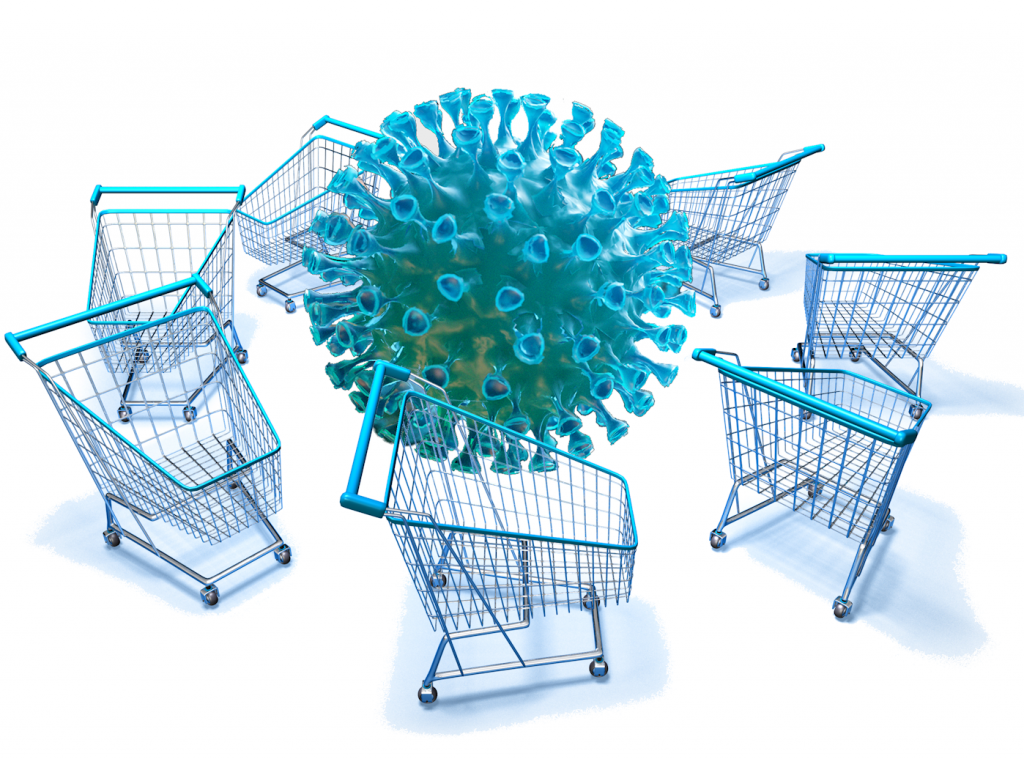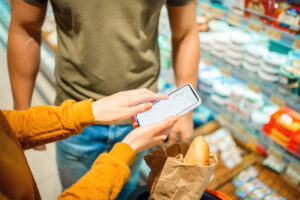We are all keenly aware of how the Covid-19 pandemic has disrupted our lives., including the ways we shop and dine. Jim Dippold, Senior Vice President for Category Management Strategy at Enterra Solutions®, put together a list of potential impacts the pandemic could have on the food sector in fourteen different areas. His insights, drawn from numerous sources, deserve a broader audience. In part one of this three-part article, I’ll look at five of Jim’s fourteen areas: Shopping Behavior Habits; Consumer Eating Habits; Retail In-store Operations; Retail Headquarter Operations; and Retailer Price and Promotion.
Shopping Behavior Habits
Facts: Consumers are likely to continue to shift their spending and shopping behavior in response to COVID-19. Probably the most notable shift will be the increase in e-commerce, home shipments, and click & collect purchases in an effort to reduce contact with others. This shift will be especially true for products consumers cannot find in-store. During the period of isolation, consumers are likely to increase purchases of goods and services related to personal comfort, healthcare, self-indulgence, and entertainment in order to experience as much safety and happiness as they can during difficult days of at-home confinement. Food is likely to play an important role in people’s lives during isolation. The purchase of meal kits and baking ingredients are likely to increase as consumers return to cooking a majority of their meals and seek new recipes to combat boredom. Whereas recent trends have favored fresh food ingredients, the isolation period will remind consumers that center-store items (i.e., goods with extended shelf life) still have a place in their pantry. Uncertainty about the length of the pandemic and social distancing will motivate consumers to continue stocking up of essential items.
Inferences: The Covid-19 pandemic is driving arguably the greatest and fastest change in shopper behavior ever. In a low-stock environment, consumers are willing to try new brands since brand loyalty is not as important as product availability. Consumers will continue to divert spending from restaurants and other away-from-home venues. Convenience store and gas station channels potentially emerge as close-to-home, easy-access options for necessities, particularly in urban areas. There are emerging opportunities for retailers to fill some consumer voids in areas like gourmet coffee and prepared foods as nonessential retailers close their doors. The most dramatic effect will be a 700% spike in demand on e-commerce. As noted above, consumers will purchase more basic ingredients and long-shelf-life items. For many consumers, this will be a period in which they try new shopping methods, new items, and adopt new shopping habits.
Consumer Eating Habits
Facts: Consumers across Asia have signaled their eating habits may change permanently once the world moves beyond the impact of the novel coronavirus outbreak. In China, where the outbreak started, 86% of consumers said they would eat at home more often than before the outbreak. A study found a high demand for more takeaway food and home food deliveries, particularly in Hong Kong, South Korea, and Thailand. These markets epitomize on-the-go lifestyles. In addition to convenience, on-the-go food offerings minimize social contacts in dining settings. Eating interests are NOT changing (i.e., people still enjoy the same types of food), but actions are changing. In some cases, people are returning to comfort meals.
Inferences: Healthy and well-loved homecooked meals may register higher on consumers’ radars than in the past. In-home eating experiences have been reset. An appreciation for long-shelf-life foods may prove lasting.
Retail In-store Operations
Facts: Online grocery shopping has become more mainstream. The pandemic has resulted in online food purchasing achieving a penetration threshold that was supposed to be achieved in 2015. Some governments have instituted mandatory social distancing for retailers to ensure proper spacing in high-traffic areas (e.g., 20% of fire capacity at one time). Retailers have implemented bonuses for employees as well as other perks (e.g., free lunch/dinner depending on their shift). Executive-level task forces have been established and are conducting daily meetings. Special shopping hours have been established for elderly consumers and for front-line or essential workers (e.g., doctors, nurses, police). Service bars and in-store dining have been closed. Product sampling has been eliminated. Reusable bags are not being used. Product returns/exchanges are no longer allowed.
Grocers are being forced to step up their game from a tech perspective (e.g., implementing curbside pickup for online orders, hired personalized shoppers, etc.). Extreme sanitization measures have been implemented (e.g., wiping carts, door handles, and other frequently-touched areas). Third-party services have been enlisted to conduct full disinfectant cleaning. Physical barriers at registers have been erected to help social distancing. Staff has been directed to wash hands frequently, get sleep, eat well, and practice social distancing. Online sales have exploded. The grocery industry is bucking employment trends by hiring rather than furloughing employees. New products are not being launched — the focus is on getting products on shelves. Wholesale costs are increasing. New stores are not being opened and existing stores are not being remodeled.
Inferences: Retailers are rethinking how to deal with self-service areas following the pandemic. Consumers are rethinking about touching things others touch or have been in close proximity to others — these practices will echo for the rest of our lives. Retailers need to develop a solid click and collect program. They will need to eat margin on essential items (to avoid the appearance of price gouging or taking advantage of the situation). The grocery sector will be one of the few employment bright spots with companies hiring supply chain and in-store staff. People will have a new appreciation for people working in the food sector.
Retail Headquarter Operations
Facts: Headquarters personnel are working remotely with vendor and internal staff. Many headquarter personnel still need to go into stores because their systems cannot be reached remotely.
Inferences: Office marketing, merchandising and supply procedures must be adopted to a remote working environment. Retailer personnel need remote internal and external meeting access. Inevitably, mistakes on orders and product quantities will be made as companies bypass normal procedures and timings. Planning for 2020 4th Quarter marketing and merchandising will be done later than normal. At some point, companies will need to catch up on the growing backlog of administrative work and planning processes.
Retailer Price and Promotion
Facts: The nature of promotion has abruptly changed from transactional to emotional. Demands on the supply chain are playing havoc with product availability and prices. The novel coronavirus pandemic is delivering billions in new sales for U.S. food retailers. Safety measures are altering operations as well as the typical margin mix. Retailers have suspended rain checks on out-of-stock promoted items. Some retailers have issued statements addressing consumer concerns about pricing, acknowledging they are taking a loss on items with skyrocketing prices, such as eggs and meat, but also highlighting the affordability of newly bought items in surplus. Some retailers have discontinued printed weekly flyers and some have changed their messaging.
Inference: Retailers need to accept delicately the unexpected bounty created by the pandemic. They need to understand the soaring costs of doing business and navigating the uncertain economic landscape. Retailers need to actively avoid and fight back gouging allegations from traumatized shoppers by absorbing targeted losses on booming sales. They need to be proactive in monitoring and managing prices for essential items (such as meat and eggs). The pandemic will spur an inevitable recession during which coupon distribution and redemption will greatly increase. Shopping behavior adopted during the recession will likely continue even after households experience financial improvements.
In part two of this article, I’ll look at four more of Jim’s areas: Retail Product Mix; Media; Supply; and Corporate Image. In the concluding part of the article, I’ll look at Jim’s final four areas, which look deeper into the future: Business Forecast; Technology; Recession; and Society and Community.





